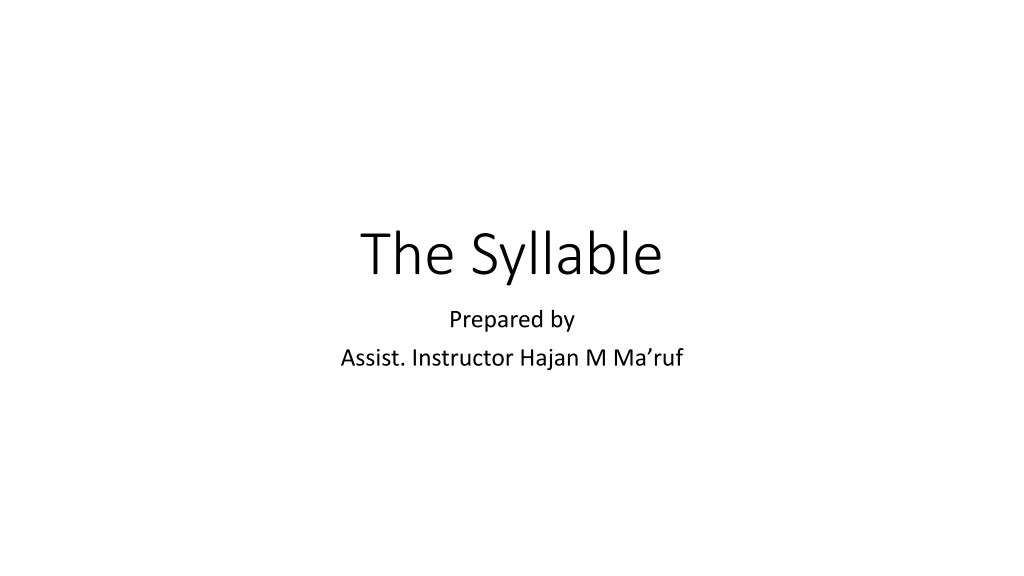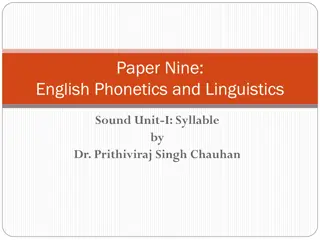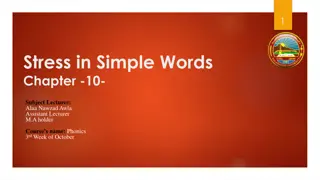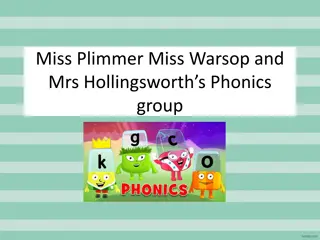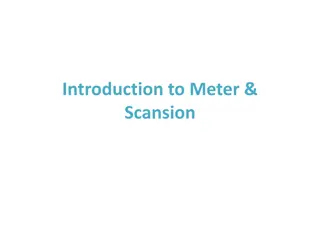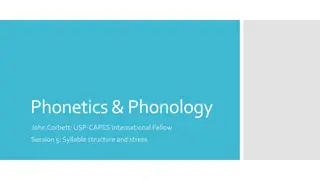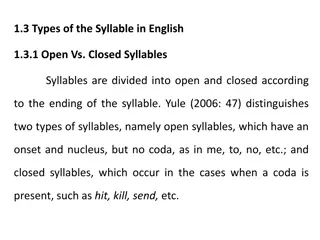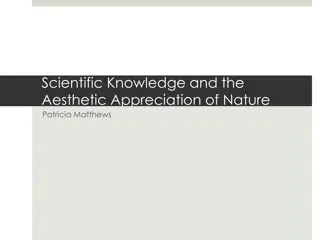Understanding the Importance and Nature of Syllables
Syllables play a crucial role in speech rhythm, yet their definition and identification can vary among individuals. The nature of syllables, encompassing vowels, consonants, onsets, and codas, can be analyzed phonetically and phonologically. This article explores syllable structures and phonotactics in English, shedding light on their significance in language.
Download Presentation

Please find below an Image/Link to download the presentation.
The content on the website is provided AS IS for your information and personal use only. It may not be sold, licensed, or shared on other websites without obtaining consent from the author. Download presentation by click this link. If you encounter any issues during the download, it is possible that the publisher has removed the file from their server.
E N D
Presentation Transcript
The Syllable Prepared by Assist. Instructor Hajan M Ma ruf
The syllable The syllable is a very important unit. Most people seem to believe that, even if they cannot define what a syllable is, they can count how many syllables there are in a given word or sentence. If they are asked to do this they often tap their finger as they count, which illustrates the syllable s importance in the rhythm of speech. As a matter of fact, if one tries the experiment of asking English speakers to count the syllables in, say, a recorded sentence, there is often a considerable amount of disagreement.
The nature of the syllable When we looked at the nature of vowels and consonants in Chapter 1 it was shown that one could decide whether a particular sound was a vowel or a consonant on phonetic grounds (in relation to how much they obstructed the airflow) or on phonological grounds (vowels and consonants having different distributions). We find a similar situation with the syllable, in that it may be defined both phonetically and phonologically. Phonetically (i.e. in relation to the way we produce them and the way they sound), syllables are usually described as consisting of a centre which has little or no obstruction to airflow and which sounds comparatively loud; before and after this centre (i.e. at the beginning and end of the syllable), there will be greater obstruction to airflow and/or less loud sound.
We will now look at some examples: i) What we will call a minimum syllable is a single vowel in isolation (e.g. the words are a:, or o:, err 3:). These are preceded and followed by silence. Isolated sounds such as m, which we sometimes produce to indicate agreement, or , to ask for silence, must also be regarded as syllables. ii) Some syllables have an onset - that is, instead of silence, they have one or more consonants preceding the centre of the syllable: bar ba: key ki: more mo: iii) Syllables may have no onset but have a coda - that is, they end with one or more consonants: am am ought o:t ease i:z iv) Some syllables have both onset and coda: ran /ran/, sat /sat/, fill /fil/
This is one way of looking at syllables. Looking at them from the phonological point of view is quite different. What this involves is looking at the possible combinations of English phonemes; the study of the possible phoneme combinations of a language is called phonotactics. It is simplest to start by looking at what can occur in initial position - in other words, what can occur at the beginning of the first word when we begin to speak after a pause. We find that the word can begin with a vowel, or with one, two or three consonants. No word begins with more than three consonants. In the same way, we can look at how a word ends when it is the last word spoken before a pause; it can end with a vowel, or with one, two, three or (in a small number of cases) four consonants. No current word ends with more than four consonants.
The structure o f the English syllable Let us now look in more detail at syllable onsets. If the first syllable of the word in question begins with a vowel (any vowel may occur, though u is rare) we say that this initial syllable has a zero onset. If the syllable begins with one consonant, that initial consonant may be any consonant phoneme except ; 3 is rare. We now look at syllables beginning with two consonants. When we have two or more consonants together we call them a consonant cluster.
Positions of consonant clusters: 1. Initial Clusters in English : 2. Medial Clusters in English: 3. Final Clusters in English :
Initial two-consonant clusters are of two sorts in English. These are of two main kinds: 1. s + one of /p,t,k,f,m,n,l,w,j/ Eg: spy. Stay ,sky, sphere, small, snow, sleep, swear, suit. sting /sti /, sway /swei/, smoke /sm uk/. 2. one of /p,t,k,b,d,g,f, , ,v,m,n,h/ + one of /l,w,r,j/: But not all of these sequences are found (e.g.*pw, *dl, do not occur in initial position) /p/+ /l,r,j/= play, pray, pure /t/ + /r,w,j/= try, twice, tune /k/ + /l,r,w,j/ =climb, cry, quite, cure
Sequences of two consonants initially one of /p,t,k,b,d,g,f, , ,v,m,n,h/ + one of /l,w,r,j/ /b/ + /l,r,j/ = blow, bread, beauty /d/ + /r,w,j/ = dress, dwell(rare), duty /g/ +/l,r/ = glass, green /f/ + /l,r,j/ =fly, from, few / / + /r,w/ =throw, thwart (rare) / / + /r/ = shriek /m/ + /j/ = music, mute /n/ + /j/ = new /h/ + /j/ =huge, human
Sequences of three consonants initially: ccc- The first sound must be /s/ + /p,t,k/ + /r,I,j,w/ These are /spr, str, skr, spj, stj, skj, spl, skw/ and are a combination of the /sp/ type of sequence and the /pr/ type. Examples: /spred/ spread, /stju:pid/ stupid, /streit/ straight, /skju / skewer /skru:/ screw, /splendid/ splendid, /spju ri s/ spurious, /skwea/ square. The sequence /spj/ is rare.
Syllable division There are still problems with the description of the syllable: an unanswered question is how we decide on the division between syllables when we find a connected sequence of them as we usually do in normal speech. It often happens that one or more consonants from the end of one word combine with one or more at the beginning of the following word, resulting in a consonant sequence that could not occur in a single syllable. For example, walked through /waikt ru:/ gives us the consonant sequence -kt r-.
We will begin by looking at two words that are simple examples of the problem of dividing adjoining syllables. Most English speakers feel that the word morning mo:ni ) consists of two syllables, but we need a way of deciding whether the division into syllables should be mo: and ni , or mo:n and i . A more difficult case is the word extra /ekstra/. One problem is that by some definitions the s in the middle, between k and t, could be counted as a syllable, which most English speakers would reject. They feel that the word has two syllables. However, the more controversial issue relates to where the two syllables are to be divided; the possibilities are (using the symbol . to signify a syllable boundary): i) e.kstra ii) ek.stra iii) eks.tra iv) ekst.ra v) ekstr.a
How can we decide on the division? No single rule will tell us what to do without bringing up problems. One of the most widely accepted guidelines is what is known as the maximal onsets principle. This principle states that where two syllables are to be divided, any consonants between them should be attached to the right-hand syllable, not the left, as far as possible. In our first example above, morning would thus be divided as mo: .ni ). If we just followed this rule, we would have to divide extra as (i) e.kstra, but we know that an English syllable cannot begin with kstr. Our rule must therefore state that consonants are assigned to the right- hand syllable as far as possible within the restrictions governing syllable onsets and codas. This means that we must reject (i) e.kstra because of its impossible onset, and (v) ekstr.a because of its impossible coda. We then have to choose between (ii), (iii) and (iv). The maximal onsets rule makes us choose (ii).
There are, though, many problems still remaining. How should we divide words like better /bet /? The maximal onsets principle tells us to put the t on the right-hand syllable, giving /be.t /, but that means that the first syllable is analysed as be. However, we never find isolated syllables ending with one of the vowels i, e, , a ,o, u, so this division is not possible. The maximal onsets principle must therefore also be modified to allow a consonant to be assigned to the left syllable if that prevents one of the vowels i, e, , a , o, u from occurring at the end of a syllable. We can then analyse the word as bet .a, which seems more satisfactory. There are words like carry /kari/ which still give us problems: if we divide the word as ka.ri, we get a syllable-final a, but if we divide it as kar.i we have a syllable-final r, and both of these are non-occurring in BBC pronunciation.
We have to decide on the lesser of two evils here, and the preferable solution is to divide the word as kar.i on the grounds that in the many rhotic accents of English this division would be the natural one to make. One further possible solution should be mentioned: when one consonant stands between vowels and it is difficult to assign the consonant to one syllable or the other - as in better and carry - we could say that the consonant belongs to both syllables. The term used by phonologists for a consonant in this situation is ambisyllabic.
Written exercise Using the analysis of the word cramped given below as a model, analyse the structure of the following one-syllable English words: Post- Pre- PostaInitial initial final Final final [ k r ] a Onset Peak cramped [m Coda p t] a) Squealed b) eighths c) splash d) texts
